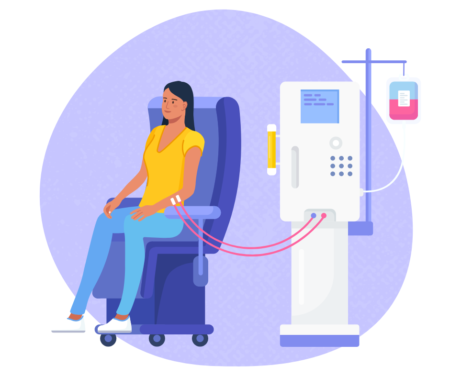Shivering is not uncommon during dialysis treatment. However, it can be a source of anxiety and discomfort. If you or your loved one has shivered during dialysis, you might have wondered why this happened.
Let’s look at the causes of shivering during dialysis and what you can do about it.
Causes of shivering during dialysis
Shivering during dialysis may be caused by the environment, dialysis process or factors within the individual. Some common causes are:
1. Infection: This is the first thing many dialysis staffs are concerned about whenever a patient on dialysis shivers, especially when there is also fever and chills. You should note that the absence of a fever does not exclude an infection. The truth is that the hemodialysis process can increase your chances of infection. This risk is higher when you are using a catheter for dialysis because the dialysis catheter is a potential portal for bacteria and organisms to enter the bloodstream.
Other pyrogenic reactions may occur from contaminants during the dialysis process.
When the body combats these infectious organisms or contaminants, it initiates inflammation throughout the body. This inflammation can cause chills, rigors and fever. While some infections may be mild and easily treatable, others are dangerous. So, it would help if you took care to guard against infections. This is why it is important to adhere to the hygiene protocol recommended by your health team to lower your chances of getting an infection.
2. Cold dialysate: During dialysis, blood is removed from the body, cleaned and returned to the body. The dialysis machine is designed to warm the blood before returning it to the body. If blood is returned to the body at a lower temperature, it drops the core body temperature and makes you feel cold.
An improperly calibrated machine or a malfunctioning one can return cold blood leading to chills and shivers.
Sometimes, dialysis centers set the machine to use cold dialysate in people with recurrent low blood pressure during dialysis, but this is not common. This could also cause chills and shivers.
3. A cold environment: Most dialysis centers are cold. The dialysis machines generate heat when working, and many dialysis centers have multiple air conditioning vents turned on to cool the environment. So, when you enter the dialysis center, you may find that it is too cold. This is particularly worse if you are not dressed warmly or the weather outside the center is warm.
4. Medical condition: If you have chronic kidney disease, you may also have anemia. This is because the kidney produces erythropoietin, a hormone that helps the body make red blood cells. Additionally, many people with chronic kidney disease also have low iron levels, and iron is essential in red blood cell production. Body cells need oxygen for metabolism and heat generation. So when you have low red blood cell levels, there’s less oxygen delivery to cells and less heat generation. This may cause you to feel cold and shiver during dialysis.
5. Hypoglycemia: If you are shivering and sweating, your blood sugar might be low. Your care team will likely run a random blood sugar test if you’re sweaty, shaky and dizzy. Hypoglycemia may happen if you’re eating poorly or have diabetes and are on glucose-lowering medications.

Who is most likely to experience shivering during dialysis?
Chills and shivers may occur in anyone who has an infection of any sort. However, people with a catheter or other devices are more likely to shiver during dialysis because of the higher risk of catheter-related infections.
Someone dialyzing for the first time may shiver because of anxiety or a reaction to some of the materials used for dialysis.
How will doctors work out what is causing the shivering?
To uncover the reason for your shivering, your doctors will ask you some questions and examine you. Sometimes the cause of your shaking is simply the dialysis center’s cold environment, especially if your bed is close to an air conditioning vent.
If you have a dialysis catheter in, your doctor will likely carefully examine the exit site for evidence of infection. But you should know that the dialysis catheter is not the only source of infection. Urinary tract infections, infections of the heart lining or any infection in general can also cause chills and shivering during dialysis.
Your doctor may need to request some investigations to determine exactly the cause of the shivering. Workup may include requests for a white blood cell count or a blood culture. For example, you may have an infection if your white blood cell count is high. A blood culture will also help determine if bacteria is present in your bloodstream.
If you are sweating and there’s a chance your blood sugar is low, your healthcare provider may request a random blood sugar.
Tips to help you stay warm during dialysis
- Follow up with your doctor to make sure there are no infections. If there is a suspicion of infection, your doctor will likely place you on some antibiotics. Make sure you take your medications judiciously to ensure all infection is cleared up.
- Wear warm clothes because most dialysis centers are usually cold. You can also ask for blankets or take your blankets with you when going for dialysis if you repeatedly shiver during your dialysis treatment.
- If you have anemia, your doctor may place you on iron supplements and injections to help your body build blood. Try to keep up with your kidney treatment. Remember that dialysis only removes waste from the body. It does not replace the other functions of the kidneys.
- Always let the dialysis staff know what is going on with you. This will allow them to monitor you closely and take actions to rectify and improve your condition.
Summary
There are many causes of shivering during dialysis treatment ranging from a cold environment to more sinister reasons like an infection. Therefore, it is crucial to report any symptoms you’re having to your healthcare provider so that you can be promptly evaluated and taken care of. In addition, simple actions like wearing warm clothes and a blanket can help keep you comfortable during your dialysis session.




